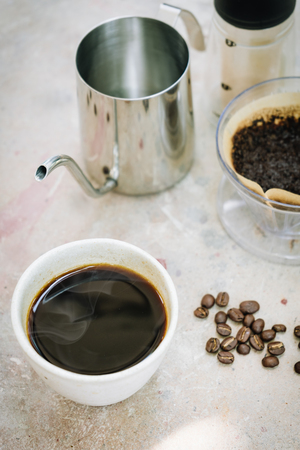1. Understanding Italian Coffee Culture
In Italy, coffee isn’t just a drink—it’s a way of life. From the bustling bars in Rome to the quiet cafés in small Tuscan towns, Italians have a unique rhythm and ritual when it comes to enjoying their daily espresso. To truly drink coffee like a local, it’s important to understand the traditions and social norms that shape this beloved part of Italian culture.
Morning Rituals
Italians typically start their day with a quick shot of espresso or a cappuccino—always paired with something light like a cornetto (Italian croissant). But there’s a catch: cappuccinos are strictly a morning drink. Ordering one after 11 AM might earn you some surprised looks from the barista.
Common Morning Coffee Choices
| Beverage | When to Drink | Typical Pairing |
|---|---|---|
| Cappuccino | Before 11 AM | Cornetto (pastry) |
| Espresso (Caffè) | Any time of day | Usually solo or after meals |
| Caffè Latte | Morning only | Bread or biscuit |
The Role of the Coffee Bar
Unlike in the U.S., where people often linger in coffee shops, Italians usually enjoy their coffee standing at the bar. It’s fast, social, and efficient. Most locals don’t spend hours working on laptops in cafés—they come in for a quick chat and an even quicker sip.
Afternoon Coffee Breaks
As the day progresses, Italians switch to simpler drinks like caffè macchiato (espresso with a dash of milk) or stick with straight espresso. Sweetened or flavored coffees are rare, and iced coffee is almost unheard of outside tourist areas.
Popular Afternoon Options
- Caffè: The classic single shot of espresso.
- Caffè Macchiato: Espresso “stained” with a small amount of milk foam.
- Caffè Corretto: Espresso with a splash of liquor like grappa or sambuca—usually reserved for special occasions or after dinner.
A Cultural Experience, Not Just Caffeine
Coffee in Italy is about more than just staying awake—it’s about community, routine, and tradition. Whether its your first espresso at sunrise or your last macchiato before dinner, every cup is part of a bigger cultural picture that defines daily life across the country.
2. The Art of Ordering Coffee in Italy
If youre visiting Italy and want to enjoy coffee like a local, knowing how to order it the right way is key. Italian coffee culture is fast-paced, especially at the bar (what Americans might call a café). Heres what you need to know to order with confidence and avoid sticking out as a tourist.
Walk Up, Don’t Wait
Unlike in the U.S., there’s no host or long wait at an Italian bar. Simply walk in, head straight to the cashier (called the cassa) to pay for your coffee first, then take your receipt (scontrino) to the counter and hand it to the barista. It’s a quick transaction that locals do every day—usually while standing at the bar.
Know Your Coffee Vocabulary
Italians use specific terms for their coffee preferences. Here are some of the most common ones:
| Italian Term | What It Means | U.S. Equivalent |
|---|---|---|
| Caffè | A single shot of espresso | Espresso |
| Caffè doppio | Double shot of espresso | Double espresso |
| Cappuccino | Espresso with steamed milk and foam, usually only before 11am | Cappuccino |
| Macchiato | Espresso “stained” with a small amount of milk | Espresso macchiato |
| Caffè latte | More milk than a cappuccino, served in a glass | Latte (Note: never just say “latte”—you’ll get a glass of milk!) |
| Caffè lungo | An espresso pulled longer for more volume and less strength | Lungo or Americano-style espresso |
The Do’s and Don’ts of Ordering Coffee in Italy
✅ Do:
- Pay first: Go to the cashier, not the counter.
- Use Italian terms: Even if you pronounce them imperfectly, locals appreciate the effort.
- Drink at the bar: It’s cheaper and faster than sitting down.
- Order quickly: Italians keep things moving—know what you want before stepping up.
❌ Don’t:
- Order fancy custom drinks: No syrups, no iced caramel swirls—it’s all about simplicity.
- Sit without paying extra: Table service costs more and is slower.
- Ask for “to-go”: Most Italians drink their coffee on the spot; takeaway isn’t common.
- Order cappuccino after lunch: This is seen as strange—milk-based drinks are for breakfast only.
A Tip from Locals:
If youre unsure what to order but want something classic, ask for “un caffè” and enjoy it like an Italian—standing up at the bar, savoring each sip in under two minutes.
The next time you step into an Italian coffee bar, remember: its not just about caffeine—its about rhythm, tradition, and enjoying the moment like a true local.

3. Espresso is King: Know Your Coffee Types
If youre trying to blend in at an Italian café, its essential to know the local coffee lingo and when to enjoy each type. Italians take their coffee seriously, and ordering the right drink at the right time can help you avoid standing out as a tourist.
Popular Italian Coffee Drinks
Heres a quick guide to the most common Italian coffee drinks and how locals typically enjoy them:
| Coffee Type | Description | When Italians Drink It |
|---|---|---|
| Espresso | A small, strong shot of coffee served in a demitasse cup | Any time of day, especially after meals |
| Macchiato | Espresso “stained” with a dash of milk foam | Morning or early afternoon |
| Cappuccino | Equal parts espresso, steamed milk, and foam | Strictly before 11 AM—never after a meal! |
| Caffè Latte | Espresso with more steamed milk and less foam than a cappuccino | Mainly at breakfast, often at home rather than in cafés |
| Caffè Corretto | Espresso “corrected” with a splash of liquor like grappa or sambuca | After dinner or on special occasions |
Timing Is Everything
In Italy, it’s not just what you drink—it’s when you drink it. One golden rule: never order a cappuccino after 11 AM. Locals believe milk-heavy drinks interfere with digestion, especially after meals. If you want to fit in, opt for an espresso instead.
The Quick Coffee Culture
Unlike in the U.S., where people often sip coffee slowly while working or chatting, Italians usually drink their coffee quickly while standing at the bar. Its more of a pit stop than a social hour.
Pro Tip:
If you’re unsure what to order, go with an espresso. It’s the safest bet and the heart of Italian coffee culture.
4. Coffee and Timing: When and What to Drink
If you want to blend in with the locals in Italy, knowing when to drink certain types of coffee is just as important as knowing what to order. Italians treat coffee as more than a beverage—its a ritual tied closely to the time of day.
Why Cappuccino After 11 a.m. Is a No-No
In Italy, cappuccino is strictly considered a breakfast drink. The combination of espresso and milk is seen as too heavy for later in the day. Ordering one after 11 a.m. might not get you kicked out of the café, but it will definitely mark you as a tourist. Italians believe that milk-based drinks can mess with digestion, especially after meals, so they avoid them post-breakfast.
How Coffee Choices Change Throughout the Day
Italians have different go-to coffee options depending on the time of day. Heres a simple breakdown:
| Time of Day | Preferred Coffee Type | Notes |
|---|---|---|
| Morning (Before 11 a.m.) | Cappuccino, Caffè Latte | Usually enjoyed with a pastry for breakfast. |
| Late Morning to Afternoon | Espresso (Caffè) | Sipped quickly at the bar; helps keep energy up. |
| After Lunch | Espresso or Macchiato | A quick shot helps with digestion after a meal. |
| Late Afternoon to Evening | Espresso or Decaf Espresso | No milk; lighter options preferred to avoid interrupting dinner appetite. |
The Role of Coffee Bars in Daily Life
Most Italians dont sit down for their coffee—they take it standing at the bar. Its quick, social, and part of their daily rhythm. Youll rarely see Italians walking around with coffee cups, either. Coffee isnt meant to be taken “to go”; its meant to be enjoyed in the moment.
Pro Tip:
If youre unsure what to order, go for an espresso (“un caffè”)—its always appropriate, any time of day.
Understanding these timing traditions will help you enjoy coffee like a true Italian—and maybe even earn you a nod of approval from the barista.
5. Bar Etiquette: How to Behave Like a Local
Italian coffee culture is all about quick, quality experiences—and that includes knowing how to act at the bar. In Italy, “bar” means a café where locals grab their daily espresso, often several times a day. To blend in and enjoy your coffee like an Italian, here are some key etiquette tips to keep in mind.
Stand, Dont Sit (Unless You Must)
Italians usually drink their coffee standing at the bar. Sitting down, especially in tourist-heavy areas, can come with extra fees. Standing not only saves money but also lets you experience the fast-paced rhythm of Italian life.
Paying: Before or After?
This depends on the bar. In many places, especially in northern Italy, youre expected to pay first at the cashier (la cassa), then take your receipt to the counter and order. In southern regions or smaller towns, its common to pay after enjoying your coffee. When in doubt, watch what others do or ask politely.
| Region | When to Pay |
|---|---|
| Northern Italy (e.g., Milan, Venice) | Pay before ordering |
| Southern Italy (e.g., Naples, Palermo) | Pay after drinking |
No Fancy Orders
Coffee orders in Italy are simple and fast. A “caffè” means a single shot of espresso. If you want milk, try a “macchiato” (espresso with a dash of milk) or a “cappuccino”—but remember, cappuccinos are usually only consumed before 11 a.m.
Tipping: Keep It Light
Tipping isn’t expected at Italian coffee bars, especially if you’re just grabbing an espresso at the counter. However, leaving small change—like 10 or 20 cents—is appreciated if service was particularly friendly or fast. If you’re seated and served by a waiter, rounding up the bill is a nice gesture.
Tipping Guide
| Sit or Stand? | Tipping Suggestion |
|---|---|
| Standing at the bar | No tip required; optional small change |
| Sitting with table service | Round up the bill or leave €0.50–€1 |
A Few More Quick Tips
- Avoid talking loudly—Italians value calm conversation over shouting.
- If its busy, make eye contact with the barista when youre ready to order.
- No need to linger—drink your coffee quickly and move on.
This relaxed but efficient style is part of what makes Italian coffee culture so unique—and enjoyable.


